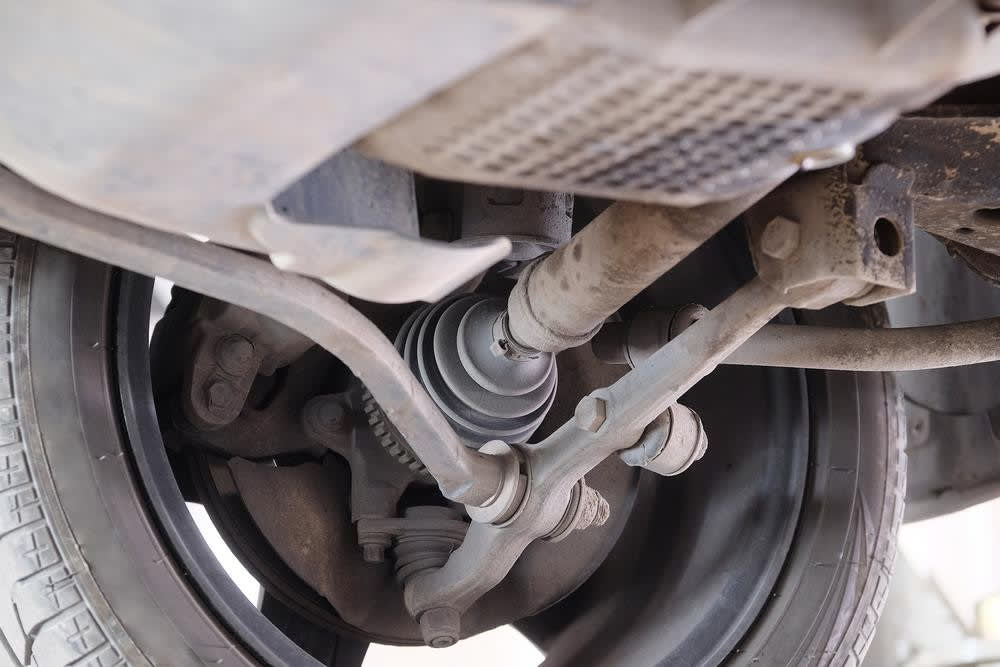

What is the CV Axle?
Constant velocity (CV) axles are a drivetrain component commonly found on many modern road-going vehicles. They serve the purpose of transferring power from the vehicle’s transmission and differential to the wheels to drive the vehicle forward. They have a greased flexible joint that allows the axle to flex according to road conditions, with minimal effect on power delivery.
The joint is lubricated with grease and covered by a rubber boot that protects it from dirt and debris. Because the CV axles are the direct link that transfers the power of the engine to the wheels, they are subject to high levels of stress over time and will eventually wear out and require replacement for proper functionality to return. When CV joints wear out, they will usually show symptoms to let the driver know they require attention.
1. Accelerating or Turning Makes Clicking Noise
One of the most common and noticeable bad CV joint symptoms is an audible clicking noise when turning or accelerating. When CV axles become excessively worn, the constant velocity joints will become loose and click when turning or accelerating. The clicks may become louder or more pronounced during sharper and faster turns and will be heard on the side with the faulty CV shaft. Alongside popping noises, you may also have a hard time steering while making turns and rounding corners.
2. Edge of Tire is Greasy
Another sign of a bad CV axle is grease on the inside edge of the tire or along the underside of the vehicle. A torn or cracked CV boot will leak grease that ends up tossed around while the axle turns. A leaky boot will eventually lead to CV joint failure, as dirt and debris will get into the boot and damage the joint. Should enough grease leak out, you may notice a growling noise from a lack of lubricant, as well as a steady knocking when driving at low speeds.
3. Excessive Vibration When Driving
Excessive vibrations while driving is another bad CV axle symptom. If a CV joint or axle shaft is damaged in any way that affects its balance while rotating, it will cause the shaft to vibrate excessively while operating the vehicle. The vibrations may oscillate, or become more pronounced as vehicle speed increases. Excessive vibration from failing CV shafts can interfere with handling and ride characteristics, and the overall safety and comfort of the vehicle. Usually, the CV axle will need to be replaced if it is damaged enough to cause vibrations. It’s crucial to buy a quality replacement CV joint if yours needs to be replaced to ensure long-term health of your vehicle.
4. Excessive Tire Wear
Another symptom of a bad CV joint is excessive wear on the edges of your tires. This can occur when the CV joint is not distributing weight evenly across the tire due to its inability to properly function. As a result, certain spots of your tire shoulder more load than others, leading to early tire wear. If you notice that your tires are wearing down faster on the edges, it's worth having your CV joint inspected by a professional.
How Serious is a Bad CV Joint?
When it comes to bad CV joint symptoms, few situations are as alarming as finding your car unable to move or extremely difficult to drive. This is often the result of ignoring earlier warning signs of a bad CV joint, leading to a worst-case scenario. A severely compromised CV joint can seriously affect vehicle drivability.
In the worst of circumstances, a completely failed CV joint means that the connection between your car's transmission and wheels is effectively broken. Without this link, power cannot be transmitted from the engine to the wheels, making your vehicle undrivable.
If left unaddressed, the symptoms listed above can rapidly become worse, resulting in a complete CV joint failure that immobilizes your vehicle. This not only requires an immediate inspection but could also imply more complex and expensive repairs. Therefore, it's critical that vehicle owners address any signs of a bad CV joint early to avoid reaching this severe level of failure.
CV axles serve as the final link between the engine and the wheels. They serve the important function of transferring the torque from the drivetrain to the vehicle’s wheels in order to move the vehicle. If you notice any bad CV joint symptoms on your vehicle , contact a technician to inspect the vehicle. They will be able to replace the CV axle for you and make any other repairs as needed.



